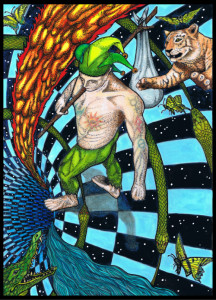The Six of Disks or Pentacles, Lord of (Material) Success, is the middle decan of Taurus, Taurus II. While Taurus itself is Venus ruled, the decan is ruled by the Moon, which is exalted in the sign. To make things even better, it is placed in Tiphareth, the sephira of the Sun. Moon and Sun, conjoined by the loving yoking of Venus, in fertile Taurus yields success.
The Hellenistic fragmentary text 36 Airs of the Zodiac attributes the Horae to this decan. The Horae were goddesses of proper timing – thus their name referring to “hours”. There were actually a few different triads of Horae. There were three seasonal goddesses known as Horae, associated with Aphrodite (Venus): Thalo of Spring, Auxo of Summer, and Carpo of Autumn. Thalo brought the spring blossom, Auxo the full plant growth, and Carpo the harvest. In the card image below, the three lower disks represent this triad, with a rose bud of spring, a full blown rose, and ripened rose hips as the fruit of the rose, the flower of Venus.
The upper three disks represent the other most common triad of Horae. Eirene (Peace), has iconography of the overflowing cornucopia, the celebratory rhyton of ale, and the scepter. Her iconography also seems very Taurean and Venusisan! Dike (Justice) is shown as the disk with the balancing scales of Justice, which is both a symbol of Venus’ other sign Libra, but also is featured in the Rider Waite Six of Pentacles card, as the scales that measure out the proper amount of alms as the figure altruistically shares the bounty with those less fortunate. The third upper disk shows an open book for Eunomia, Order – a goddess whose name refers to “good laws” – and also makes a pun on “fields” for the agricultural motif. The open book also is a symbol of the Priestess, for the Moon as ruler of the decan. The disks all have a hexagonal (six-sided) insert, for the sixth sephira of the Sun.
These two triads make for six goddesses, shown as dancing maidens on the hillside. I admit that these dancing maidens were totally inspired by a famous Pre-Raphaelite painting (now in the public domain). They were too perfect to pass up, as they appear to be dancing in a ring, and the central flower-wreathed and beribboned pole – very phallic-yonic – is none other than the Maypole. This pole shows the result at the end of their dance, when the ribbons have been successfully wound to the end in a ritual fertility rite performed by young maidens at Beltane, which falls in this decan.
There were also Horae associated with goddesses of the four seasons, who were said to be children of Helios (the Sun) and Selene (The Moon) – the two drivers of agricultural timing for the Earth. We see this fortunate pairing above, with Selene as the crescent and curving female form conjunct the solar-rayed face of Helios.
But what about the decan imagery? Glad you asked!
The major image to hit correctly comes from 777: A man of like figure (to the ascendant decan, aka the female figure from the 5 of Disks) with cloven hoofs like an ox.
So, torn clothing like the Five’s figure, cloven hoofs; check. He is carrying a cauldron of spring flowers and a key, as the image also pulled (cherry-picked!) from other decan sources:
Liber Hermetis: Its image is a man, erect (note to self: do they mean erect or “erect” – guess the pole is a stand in here), having tightly curled hair on both sides of the head. On his chin there is a growing of fine hairs and on his face there is a beard hanging down on his neck from both parts of his chin.
Picatrix: A man like figure of a camel and having on his fingers are hooves like those of cows, and he is completely covered by a torn linen sheet. He desires to work the land, to sow, and to make things…
Agrippa: In the second face there ascendeth a naked man, holding in his hand a key; it giveth power, nobility and dominion over people.
Vedic:…a man with a discriminative intellect with good knowledge of lands, grains, houses, cows, arts, ploughing and carts, hungry, sheep faced, dirty clothes and shoulders like the hump of an ox…
Lastly, the Egyptian god form is Helitomenos, or sanctuary of Helios.
[coming soon]
